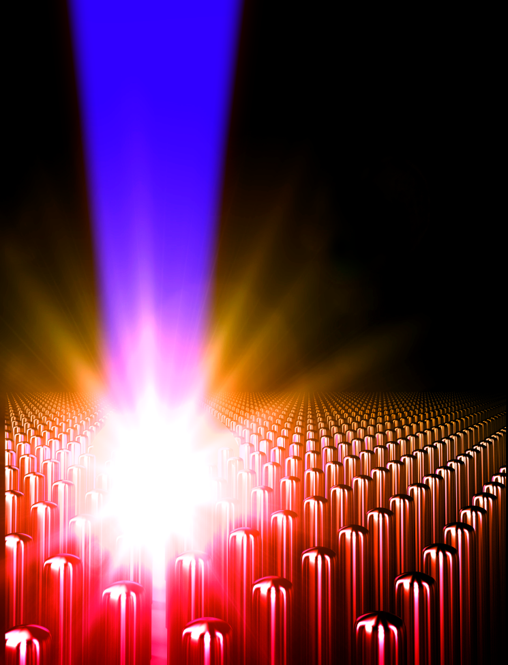
We are studying physics of the interaction of ultra-intense laser laser pulses with nanostructures and their promising applications in x-ray and gamma ray generation, ion and electron acceleration, and fusion neutron generation. By trapping femtosecond laser pulses of relativistic intensity deep within ordered nanowire arrays we have volumetrically heated dense matter into a new ultra-hot plasma regime [1]. Electron densities more than 100 times greater than that in conventional laser matter interaction experiments, and temperatures of tens of millions of K degrees are achieved using ultrashort laser pulses of only one Joule energy. Extraordinarily high degrees of ionization (e.g. 52 times ionized Au) are observed with gigabar pressures only exceeded in the laboratory in the central hot-spot of highly compressed thermonuclear fusion plasma. The large electron density, which shortens the radiative lifetime combined with the large plasma volume that increases the hydrodynamic cooling time allow for greatly increased conversion into x-rays. Recent experiments in which gold nanowire arrays were heated by ultra-high contrast laser pulses produced record 20 percent conversion efficiency into picosecond x-ray pulses [2].
Selected publications
[1] M.A. Purvis, V.N. Shlyaptsev, R. Hollinger, C. Bargsten, A. Pukhov, A. Prieto, Y. Wang, B.M. Luther, L. Yin, S.J. Wang, and J. J. Rocca, “Relativistic plasma nano-photonics for ultra-high energy density physics,” Nature Photonics vol. 7,796, (2013).
[2] C. Bargsten, R. Hollinger, M.G. Capeluto, V. Kaymak, A. Pukhov, S.J. Wang, A. Rockwood, Y. Wang, D. Keiss, R. Tommasini, R. London, J. Park, M. Busquet, M. Klapisch, V.N. Shlyaptsev, and J. J. Rocca, “Energy penetration into arrays of aligned nanowires irradiated with relativistic intensities: Scaling to terabar pressures”. Science Advances. 3e1601558, (2017).10.1126/sciadv.1601558
[3] R. Hollinger, C. Bargsten, V.N. Shlyaptsev, V. Kaymak, A. Pukhov, M.G. Capeluto, S.J. Wang, A. Rockwood, Y. Wang, A. Townsend, A. Prieto, P. Stockton, A. Curtis, and J. J. Rocca, “Efficient picosecond x-ray pulse generation from plasmas in the radiation dominated regime”. Optica. vol.4 (2017) .10.1364/optica.4.001344.
[4] C. Bargsten, R. Hollinger, M.G. Capeluto, V. Kaymak, A. Pukhov, S.J. Wang, A. Rockwood, Y. Wang, D. Keiss, R. Tommasini, R. London, J. Park, M. Busquet, M. Klapisch, V.N. Shlyaptsev, and J. J. Rocca, “Energy Penetration into Arrays of Aligned Nanowires Irradiated with Relativistic Intensities: Scaling to Terabar Pressures,” Science Advances, 3, e1601558, (2017).
[5] A.Curtis, C. Calvi, J. Tinsley, R. Hollinger, V. Kaymak, A. Pukhov, S.J. Wang, A. Rockwood, Y. Wang, V.N. Shlyaptsev, and J. J. Rocca, “Micro-Scale Fusion in Dense Relativistic Nanowire Array Plasmas,” Nature Communications, 9, 1077, (2018).
[6] Dozieres, G. M. Petrov, P. Forestier-Colleoni, P. Campbell, K. Krushelnick, A. Maksimchuk, C. McGuffey, V. Kaymak, A. Pukhov, M. G. Capeluto, R. Hollinger, V. N. Shlyaptsev, J. J. Rocca, and F. N. Beg, “Optimization of Laser-Nanowire Target Interaction to Increase the Proton Acceleration Efficiency,” Plasma Physics and Controlled Fusion, 61, 065016, (2019).
[7] R. Hollinger, S. Wang, Y. Wang, A. Moreau, M.G. Capeluto, H. Song, A. Rockwood, E. Bayarsaikhan, V. Kaymak, A. Pukhov, V.N. Shlyaptsev, and J.J. Rocca, “Extreme ionization of heavy atoms in solid-density plasmas by relativistic second-harmonic laser pulses,” Nature Photonics, 14, (2020).
[8] M. Bailly-Grandvaux, D. Kawahito, C. McGuffey, J. Strehlow, B. Edghill, M.S. Wei, N. Alexander, A. Haid, C. Brabetz, B. Bagnoud, R. Hollinger, M.G. Capeluto, J.J. Rocca, and F.N. Beg, “Ion acceleration from microstructured targets irradiated by high-intensity picosecond laser pulses,” Physical Review E, 102, 021201, (2020).
Funding
Work supported by the U.S. Department of Energy, Fusion Science program of the Office of Science, LaserNet US and by the Air Force Office of Scientific Research.
